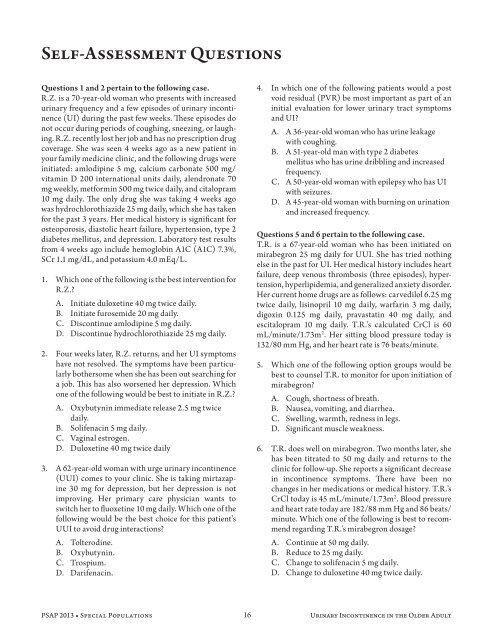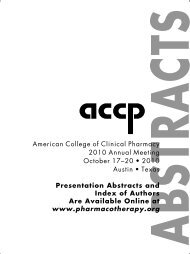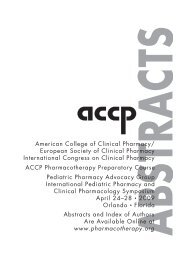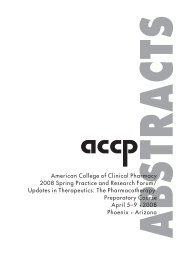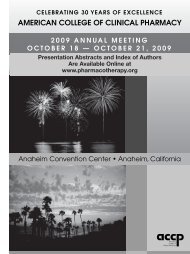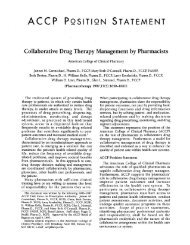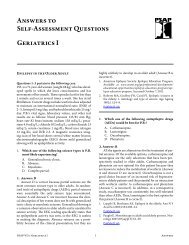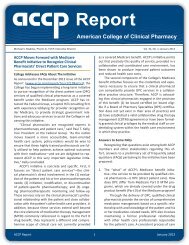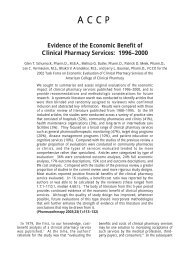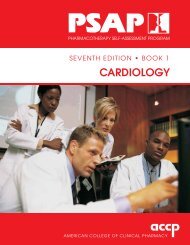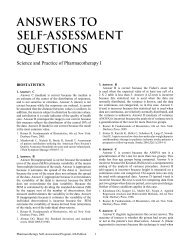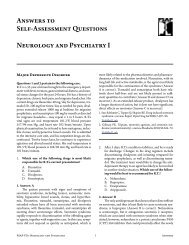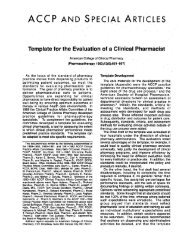Sample PDF - ACCP
Sample PDF - ACCP
Sample PDF - ACCP
Create successful ePaper yourself
Turn your PDF publications into a flip-book with our unique Google optimized e-Paper software.
Self-Assessment Questions<br />
Questions 1 and 2 pertain to the following case.<br />
R.Z. is a 70-year-old woman who presents with increased<br />
urinary frequency and a few episodes of urinary incontinence<br />
(UI) during the past few weeks. These episodes do<br />
not occur during periods of coughing, sneezing, or laughing.<br />
R.Z. recently lost her job and has no prescription drug<br />
coverage. She was seen 4 weeks ago as a new patient in<br />
your family medicine clinic, and the following drugs were<br />
initiated: amlodipine 5 mg, calcium carbonate 500 mg/<br />
vitamin D 200 international units daily, alendronate 70<br />
mg weekly, metformin 500 mg twice daily, and citalopram<br />
10 mg daily. The only drug she was taking 4 weeks ago<br />
was hydrochlorothiazide 25 mg daily, which she has taken<br />
for the past 3 years. Her medical history is significant for<br />
osteoporosis, diastolic heart failure, hypertension, type 2<br />
diabetes mellitus, and depression. Laboratory test results<br />
from 4 weeks ago include hemoglobin A1C (A1C) 7.3%,<br />
SCr 1.1 mg/dL, and potassium 4.0 mEq/L.<br />
1. Which one of the following is the best intervention for<br />
R.Z.?<br />
A. Initiate duloxetine 40 mg twice daily.<br />
B. Initiate furosemide 20 mg daily.<br />
C. Discontinue amlodipine 5 mg daily.<br />
D. Discontinue hydrochlorothiazide 25 mg daily.<br />
2. Four weeks later, R.Z. returns, and her UI symptoms<br />
have not resolved. The symptoms have been particularly<br />
bothersome when she has been out searching for<br />
a job. This has also worsened her depression. Which<br />
one of the following would be best to initiate in R.Z.?<br />
A. Oxybutynin immediate release 2.5 mg twice<br />
daily.<br />
B. Solifenacin 5 mg daily.<br />
C. Vaginal estrogen.<br />
D. Duloxetine 40 mg twice daily<br />
3. A 62-year-old woman with urge urinary incontinence<br />
(UUI) comes to your clinic. She is taking mirtazapine<br />
30 mg for depression, but her depression is not<br />
improving. Her primary care physician wants to<br />
switch her to fluoxetine 10 mg daily. Which one of the<br />
following would be the best choice for this patient’s<br />
UUI to avoid drug interactions?<br />
A. Tolterodine.<br />
B. Oxybutynin.<br />
C. Trospium.<br />
D. Darifenacin.<br />
4. In which one of the following patients would a post<br />
void residual (PVR) be most important as part of an<br />
initial evaluation for lower urinary tract symptoms<br />
and UI?<br />
A. A 36-year-old woman who has urine leakage<br />
with coughing.<br />
B. A 51-year-old man with type 2 diabetes<br />
mellitus who has urine dribbling and increased<br />
frequency.<br />
C. A 50-year-old woman with epilepsy who has UI<br />
with seizures.<br />
D. A 45-year-old woman with burning on urination<br />
and increased frequency.<br />
Questions 5 and 6 pertain to the following case.<br />
T.R. is a 67-year-old woman who has been initiated on<br />
mirabegron 25 mg daily for UUI. She has tried nothing<br />
else in the past for UI. Her medical history includes heart<br />
failure, deep venous thrombosis (three episodes), hypertension,<br />
hyperlipidemia, and generalized anxiety disorder.<br />
Her current home drugs are as follows: carvedilol 6.25 mg<br />
twice daily, lisinopril 10 mg daily, warfarin 3 mg daily,<br />
digoxin 0.125 mg daily, pravastatin 40 mg daily, and<br />
escitalopram 10 mg daily. T.R.’s calculated CrCl is 60<br />
mL/minute/1.73m 2 . Her sitting blood pressure today is<br />
132/80 mm Hg, and her heart rate is 76 beats/minute.<br />
5. Which one of the following option groups would be<br />
best to counsel T.R. to monitor for upon initiation of<br />
mirabegron?<br />
A. Cough, shortness of breath.<br />
B. Nausea, vomiting, and diarrhea.<br />
C. Swelling, warmth, redness in legs.<br />
D. Significant muscle weakness.<br />
6. T.R. does well on mirabegron. Two months later, she<br />
has been titrated to 50 mg daily and returns to the<br />
clinic for follow-up. She reports a significant decrease<br />
in incontinence symptoms. There have been no<br />
changes in her medications or medical history. T.R.’s<br />
CrCl today is 45 mL/minute/1.73m 2 . Blood pressure<br />
and heart rate today are 182/88 mm Hg and 86 beats/<br />
minute. Which one of the following is best to recommend<br />
regarding T.R.’s mirabegron dosage?<br />
A. Continue at 50 mg daily.<br />
B. Reduce to 25 mg daily.<br />
C. Change to solifenacin 5 mg daily.<br />
D. Change to duloxetine 40 mg twice daily.<br />
PSAP 2013 • Special Populations 16 Urinary Incontinence in the Older Adult


